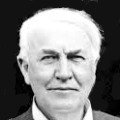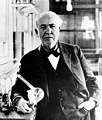Thomas Edison Inventions
 Edison left school at the age of 7 and was educated by his mother at their home in Port Huron, Michigan.
Edison left school at the age of 7 and was educated by his mother at their home in Port Huron, Michigan.
Nancy Edison would borrow books from the library and read them to her son to encourage his passion for learning.
Edison was interested in books that showed how things were made and how to conduct experiments.
When he was a teenager, he got a job selling newspapers to passengers on the day-train that traveled from his hometown to Detroit and back. The train would have a layover of a few hours in Detroit before returning to Port Huron.
Edison received permission from the railroad to do chemistry experiments in the baggage car while waiting for the return trip.
Working at the railway provided the young Edison with a unique experience. He was able to observe and learn more about steam engines, electricity and the telegraph, but he also was learning how to interact and sell to people.
Understanding the reasons why people purchased products had a great influence on his career and on his methods of invention.
Thomas Edison was interested in practical applications rather than theory.
He wanted to know how something would work rather than the theory of why it worked that way.
He was not as interested in discovering something new, as much as he was interested in discovering how something new could be improved - so it would be a viable benefit to others.
Many of the Thomas Edison inventions were substantial improvements to existing products that were not marketable. In this regard, Edison was as much an entrepreneur and as he was an inventor.
These improvements allowed many his inventions to be successfully commercialized.
Telegraph
Edison left the railroad and took a job as a telegraph operator for Western Union.
He wanted to know how a telegraph worked so he would take it apart and reassemble it. He eventually made dozens of technical improvements to the telegraph.
The most significant innovation allowed for multiple messages to be sent and received simultaneously over the same wire. This was completely new and it transformed the telegraph industry.
Edison filed for patents and sold his invention to Western Union.
There is an amusing story that Edison tells about his meeting with Western Union.
Edison Light Bulb
 The electric light bulb is an example of one of Edison's inventions that took an existing idea and made significant improvements so it could be sold as a viable benefit to others.
The electric light bulb is an example of one of Edison's inventions that took an existing idea and made significant improvements so it could be sold as a viable benefit to others.
Humphry Davy, an English scientist, discovered that carbon would glow when it received an electrical current. Sir Joseph Swan, also an English scientist, discovered that a carbon paper filament would glow better but was not long-lasting.
The concept of electric light was a unique invention, however, if the glowing carbon only lasted briefly then it had no viable benefit compared to the gas lighting that most homes were using.
So Edison decided to employed research assistants, many of whom were scientists, to conduct thousands of experiments to find a carbon composition that would glow brightly and be long-lasting.
He sent people all over the world to look for plant materials that could be used in his experiments.
A new filament material was created and placed within a bulb, which created light for more than 1500 hours.
A manufacturing process was also patented that would mass produce the light bulbs at an economic cost that was affordable and profitable.
Edison's intention was to provide better lighting, at a lower cost and higher profit, than gas companies. So he also created an entire system (cable wiring, generating stations, meters) that would supply electricity to homes.
All of this research was conducted at his Menlo Park Laboratory. The Laboratory was actually two city blocks of buildings purchased from a failed real estate developer in Raritan Township, New Jersey.
Many of the worlds top scientists and inventors, such as Nikola Tesla and Reginald Fessenden, worked for Edison at this facility.
John Ott, Jonas Aylsworth, Lewis Latimer, Ezra Gilliland, George M Phelps, Arthur Kennelly and Josph B Stearns were some of the other inventors that worked with Edison.
Edison used methods similar to his friend, Henry Ford, who was also an inventor. Ford did not invent the automobile but invented methods of mass producing automobiles so that they were affordable.
One of Edison's inventions that helped Ford was the car battery.
Ingenuity
The ingenuity of the Thomas Edison inventions was the research behind them. This research was extensive and thorough. Edison created products that people wanted, that they could afford, and that he could manufacture for a profit.
Edison would determine needs and fulfill them. When electricity was introduced to homes, people were concerned about getting shocked or electrocuted.
Electricity was something new and mysterious. People were worried that bolts of current could fly out of the outlets on their walls. They believed this was possible if nothing was plugging the holes in the outlets.
Instead of explaining how this was improbable, which people wouldn't understand, Edison decided to invent and market covers to put over the outlets. Consumers bought them and felt a lot better and more comfortable.
Edison was as gifted an entrepreneur as he was an inventor, which explains to a large extent his success.



